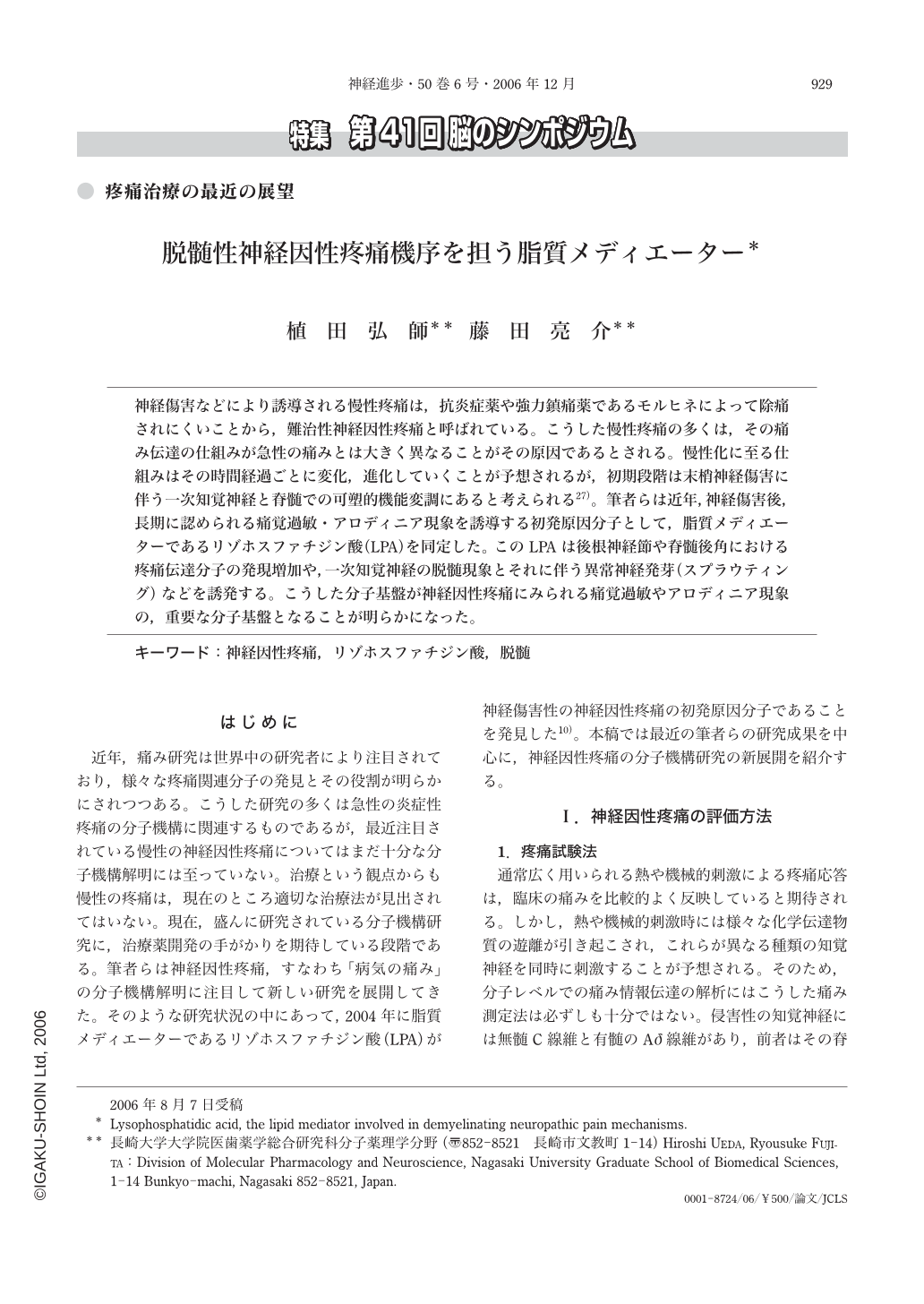Japanese
English
- 有料閲覧
- Abstract 文献概要
- 1ページ目 Look Inside
- 参考文献 Reference
神経傷害などにより誘導される慢性疼痛は,抗炎症薬や強力鎮痛薬であるモルヒネによって除痛されにくいことから,難治性神経因性疼痛と呼ばれている。こうした慢性疼痛の多くは,その痛み伝達の仕組みが急性の痛みとは大きく異なることがその原因であるとされる。慢性化に至る仕組みはその時間経過ごとに変化,進化していくことが予想されるが,初期段階は末梢神経傷害に伴う一次知覚神経と脊髄での可塑的機能変調にあると考えられる27)。筆者らは近年,神経傷害後,長期に認められる痛覚過敏・アロディニア現象を誘導する初発原因分子として,脂質メディエーターであるリゾホスファチジン酸(LPA)を同定した。このLPAは後根神経節や脊髄後角における疼痛伝達分子の発現増加や,一次知覚神経の脱髄現象とそれに伴う異常神経発芽(スプラウティング)などを誘発する。こうした分子基盤が神経因性疼痛にみられる痛覚過敏やアロディニア現象の,重要な分子基盤となることが明らかになった。
Many known painkillers, such as non-steroidal anti-inflammatory drugs and morphine are not always effective in the therapy of chronic neuropathic pain manifested by hyperalgesia and tactile allodynia. It may come from the fact that the mechanisms underlying neuropathic pain markedly differ from acute and inflammatory pain. Although recent advances in pain research provide us with a clear picture for the molecular mechanisms of acute pain, they are not enough for chronic neuropathic pain mechanisms. In our approaches we have attempted to separately characterize the behavioral responses through different types of nociceptive or even innocuous fibers, and to compare them between normal and neuropathic pain model animals. For this purpose we developed new nociception tests, algogenic-induced paw flexion(APF), electric stimulation-induced paw flexion(EPF)and withdrawal(EPW)tests.
From these studies, it was revealed that type 1 C-fibers are neo-natal capsaicin-sensitive, and use substance P/NK1 receptor for pain transmission, type 2 C-fibers are also capsaicin-sensitive, but use glutamate/NMDA receptor, Aδ-fibers are capsaicin-insensitive and use glutamate/NMDA receptor, and Aβ-fibers are also capsaicin-insensitive and use glutamate/non-NMDA(AMPA-kainate)receptor.
Following partial sciatic nerve-injury to induce neuropathic hyperalgesia and allodynia, type-1 C-fiber function is largely attenuated, possibly through a down-regulation of spinal substance P expression. Bradykinin B2-receptor in type 1 C-fibers is down-regulated, while B1-receptor is expressed in A-fibers. The up-regulation of α2δ1-subunit of Ca channel and TRPV1 capsaicin receptor was observed in A-fibers. These findings are consistent with the observation that the threshold of nociceptive responses by C-fiber stimulation is increased in the EPF or EPW test, while those by Aδ-and Aβ-fiber stimulations are decreased. Of interest are the findings that nerve-injury-induced neuropathic pain is abolished by intrathecal injection of botulinum C3 toxin(BoTN/C3), marked BoTN/C3-sensitive demyelination is observed in the dorsal root, and intrathecal lysophosphatidic acid(LPA)also causes BoTN/C3-sensitive neuropathic pain. From the idea that Schwann cell expresses LPA1 receptor, which causes morphological changes in various cells through BoTN/C3-sensitive Rho protein activation, we examined the possibility of LPA1 receptor-involvement in neuropathic pain and demyelination. The experiments using LPA1 receptor knock-out mice revealed that all these changes in the nerve injury-induced or LPA-administered neuropathic pain model mice are mediated by the activation of LPA1 receptor, RhoA and Rho kinase.

Copyright © 2006, Igaku-Shoin Ltd. All rights reserved.


